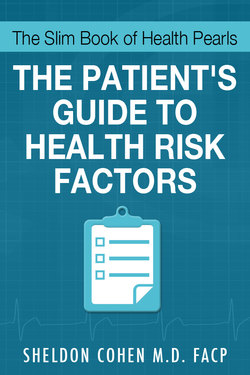Читать книгу The Slim Book of Health Pearls: Am I At Risk? The Patient's Guide to Health Risk Factors - Sheldon Cohen M.D. FACP - Страница 3
На сайте Литреса книга снята с продажи.
ОглавлениеCHAPTER 1
INTRODUCTION
Take calculated risks. That is quite different from being rash.
General George S. Patten
1885–1945
You are at risk of losing money if you purchase a stock, bet on a horse, or sit down at a poker table. The risk to your financial health can be great if you bet more than you can afford; it can be minimal if you decide to bet two dollars when your net worth is over a million.
When it comes to your life, risk is different. More often than not, your well-being is at stake. And since you have only one life to live—why gamble with risks to your health?
But many people do gamble, either because they don’t know what the risks are, or, knowing them, they just don’t care; they adopt a fatalistic approach. They are proud of saying, “When your number’s up, it’s up.”
Both categories of patients should read this book: the former, because it is important to know how to prevent a serious acute or chronic illness; and the latter, because it’s time to wake up and change your attitude—especially since paying attention to health risk factors could save your life.
A risk factor is something that may increase your chance of developing an illness. The something refers to how you live your life, your ancestor’s genes, what you might do, what you might not do, your age, your sex, your exposure to certain products, your eating habits, how much you exercise—or do not, your size and weight, whether you smoke or not, etcetera. There are many more.
You will come up with the probability of developing an illness if you put risk factors together. The laws of probability are amazingly precise. They allow us to have lotteries and even though the chance of buying the winning ticket may be one in many millions, if enough people buy a ticket there will always be a winner. That is a guarantee.
In the same way, if one has one risk factor for an illness there is less probability of acquiring it than if one has multiple risk factors. This is true for the most part, unless the one risk factor is overwhelmingly important—smoking, for instance.
So, with this in mind, we will discuss risk factors for the most common illnesses that may end our lives, or will cause a state of chronic disability.
There are some risk factors that you have no control over, but there are others that you have complete control over. So if you have a number of the controllable risk factors, then you need to be certain that those risk factors are controlled to the greatest extent possible.
Are there any guarantees? No, but you can increase the odds that you will not become a victim, just as betting on more horses will increase the odds that you will pick the winning horse.
Remember, by analyzing your risk factors you are practicing early detection and prevention.
That is the name of the game.
So we will list those illnesses that you will have the greatest chance of acquiring during your life time, and we will take them one at a time and discuss the risk factors for each one and what you need to do to minimize your risk.
The illnesses are as follows:
1.Disease of the heart (heart attack)
2.Cancer (most common: lung, breast, ovary, prostate, colon, skin, pancreas)
3.Stroke (cerebrovascular disease)
4.Chronic lower respiratory disease (emphysema, chronic bronchitis)
5.Unintentional injuries (accidents)
6.Diabetes mellitus
7.Influenza (flu) and Pneumonia
8.Alzheimer’s disease
9.Kidney disease (nephritis and nephrosis)
10.Septicemia (severe infection)
11.Intentional self harm (suicide)
12.Liver disease (chronic hepatitis, cirrhosis)
13.Essential hypertension (high blood pressure)
14.Osteoporosis
15.Depression
16.Anxiety
The first three on this list (heart-cancer-stroke) constitutes about sixty percent of the causes of death in this country.
All of us should have a risk factor analysis. Besides telling us what we are at risk for it is extremely educational, as the risk factors and the illnesses are closely identified. This is in sharp contrast to the usual medical history that mentions some risk factors but does not make the connection between the risk factor and the illness.
So let’s learn about specific risks. At the completion of each discussion, you are invited to take a quiz to determine whether you have some of the risk factors for a specific illness. When you finish, take the results to your physician. You can be a great help to him or her. You are being encouraged to be proactive.
Busy physicians need your help!
The format of this book will be as follows:
I will first discuss some generalities about the illness.
I will tell you the risk factors for the illness in question.
A set of risk factor questions for each illness will follow the above.
Again, I invite you to answer these questions and learn about your vulnerabilities.
